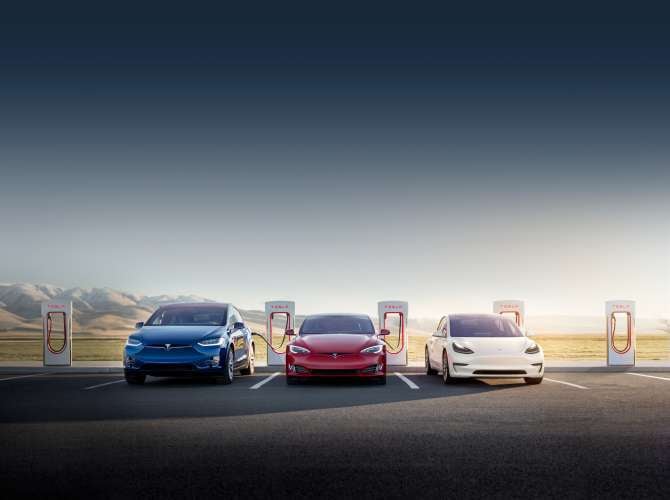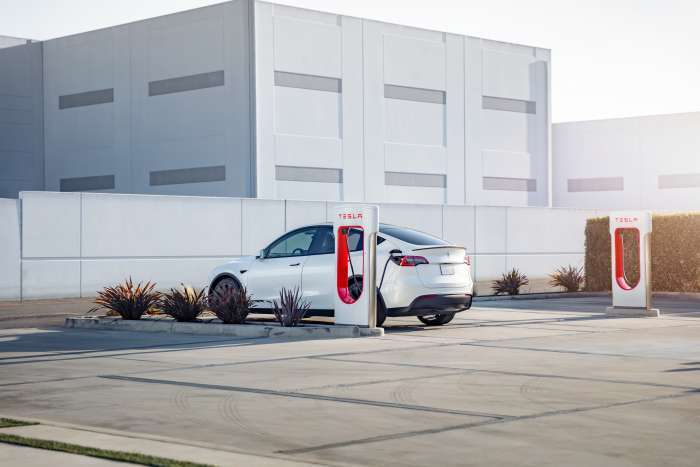Almost coinciding with that milestone, Tesla has just updated the billing system for each charging session. Up until now a fixed price was used for the whole day, although the electricity market does not really work that way: the cost of energy is actually very variable, depending on many different factors. Now Tesla goes from flat rate to a more dynamic one, with time slots and different prices. But it would be good to refer to the European Supercharger network in more depth before actually getting to the dynamic, time based prices.
Going back in time, in early 2015 the first European Supercharger was upgraded with a 'solar canopy' (a carport with solar cells on the roof) in Køge, Denmark. According to the person responsible for Tesla's Superchargers in the Nordic countries, Christian Marcus, the 12-stall Supercharger in Køge had 300 m2 (3,230 sq ft) solar cells with a projected annual production of about 40 MWh and was equipped with its own battery bank for temporary storage of excess production.

Unlike most other European Supercharger stations, Tesla bought the land on which the Køge Supercharger stands. On April 26, 2016, Kostomłoty became the first charger to open in Poland. Tesla also opened a grid-connected 2-stall Supercharger at Nürburgring, Germany, in 2019. There are also a few privately operated Supercharger stations such as the one in Zarechye, Russia, with 3 stalls.
The European Supercharger network is planned to allow a Model S to drive from the North Cape (near Honningsvåg) in Norway to Istanbul or Lisbon. As of March 2021, the Supercharger closest to Istanbul is the one in Plovdiv (Bulgaria), and the one nearest to Lisbon is "Alcácer do Sal". The map of current and planned sites includes every European Union country except Malta and Cyprus, and represents all of the countries in the world in the top 10 of electric vehicle adoption rates.
Tesla started testing the charging of non-Tesla cars in the Netherlands back in 2021, and in Norway in early 2022, at 15 large Supercharging stations. Tesla cars have priority in all cases.
Going back to dynamic charging, and to give an example in Germany, the Kamen Supercharger has a price of 0.56 euros/kWh between 00:00 and 06:00, and from 22:00 to 00:00; while the rest of the day it goes to 0.74 euros/kWh. In Spain, the "Nuevos Ministerios" Supercharger in Madrid, in the SABA car park, uses the same time slots, but the price is lower by an interesting margin: the lower part of the dynamic rate costs 0.50 euros/kWh and the higher part 0.55 euros/kWh.

But how noticeable is that when charging your EV? In the German case, when charging 50 kWh, the difference would be from 37 to 28 euros, that is, only 9 euros. In the Spanish case, the 50 kWh at the peak rate would cost 27.5 euros, while at the off-peak rate it would be only 2.5 euros less. That difference is rather laughable, and it is hardly worth making changes in planning for the cost of a couple of coffee "lattes".
There are actually some precedents in the United States for the dynamic rate when using Superchargers. For example, in April it was possible to charge at 0.48 dollars/kWh at the peak rate, and at only 0.24 dollars/kWh between 9:00 p.m. and 11:00 a.m., thus trying to concentrate charging at more favorable times in California, where more Tesla users are concentrated. As always, it must be remembered to remove the plug when it is due time,at the risk of paying an occupancy fee. At a rate of 1 euro per minute, occupying a space that could be used by another EV driver waiting in line is penalized: for only 30 minutes overtime the cost of the charging session basically doubles.
All images courtesy of Tesla Inc.
Nico Caballero is the VP of Finance of Cogency Power, specializing in solar energy. He also holds a Diploma in Electric Cars from Delft University of Technology in the Netherlands, and enjoys doing research about Tesla and EV batteries. He can be reached at @NicoTorqueNews on Twitter. Nico covers Tesla and electric vehicle latest happenings at Torque News.











